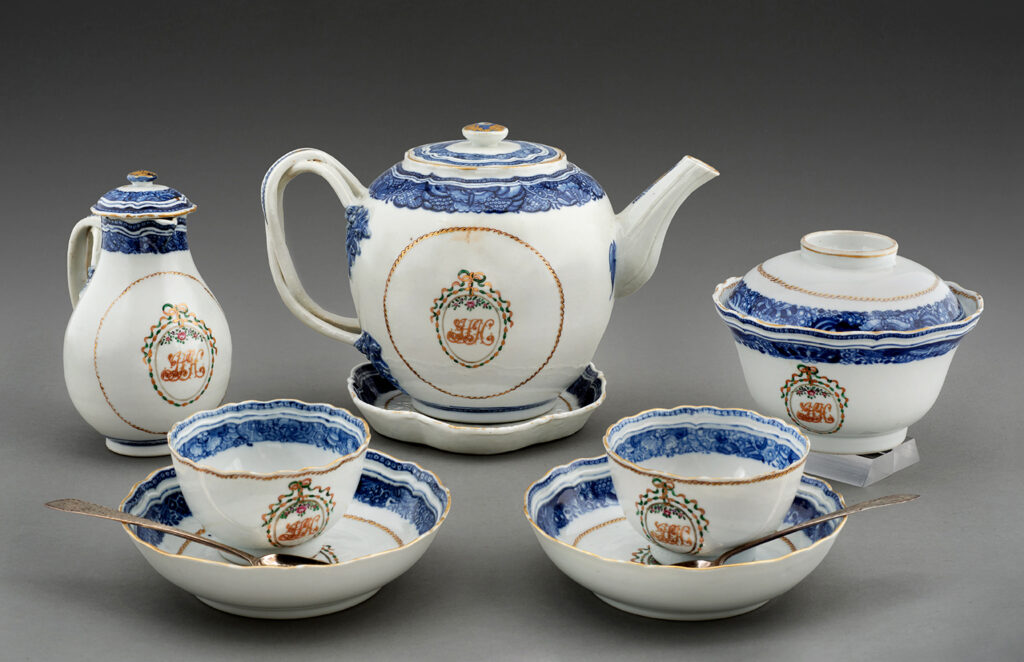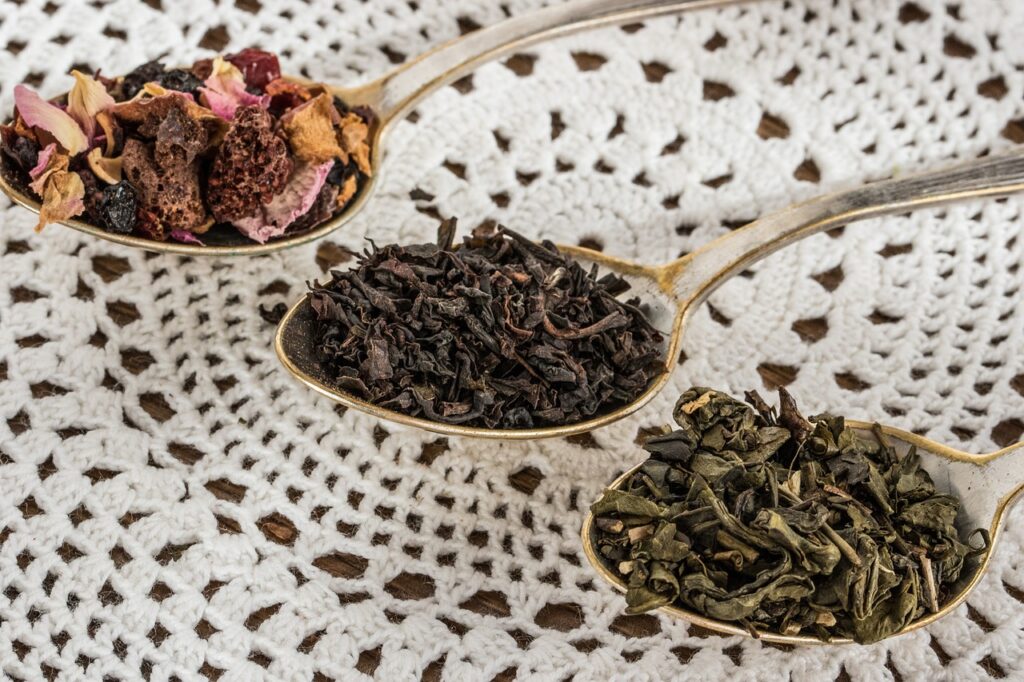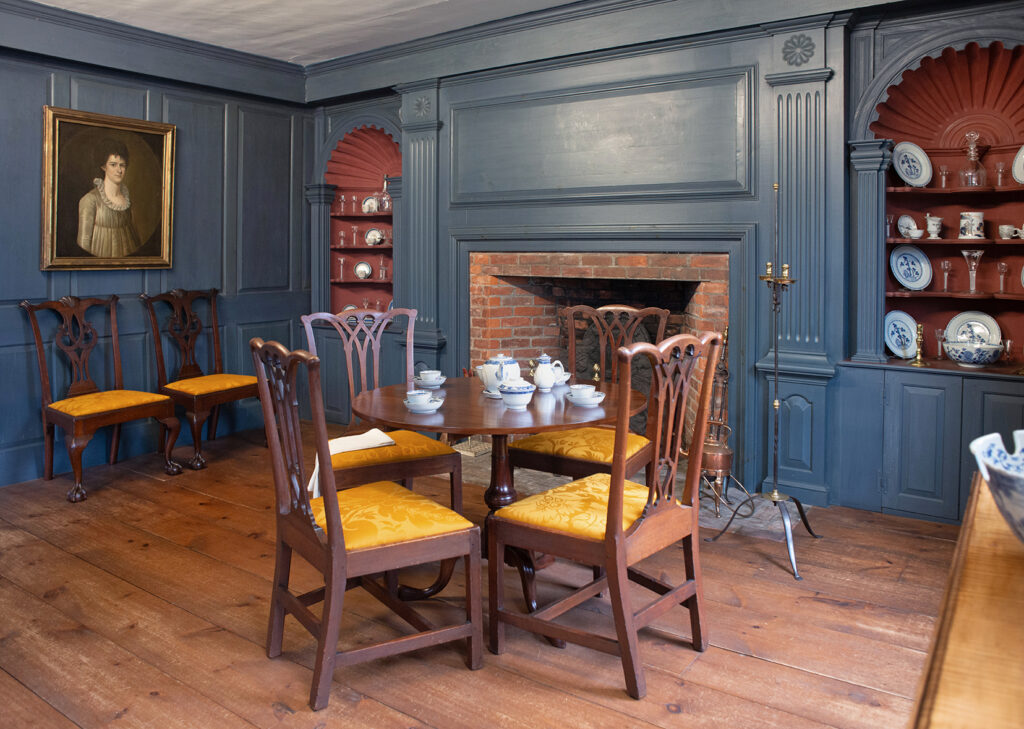
By Samantha Frost, Collections Care Technician
As was the case with many cities and towns throughout the North American colonies, political, economic, and ideological differences divided Deerfield during the American Revolution. It is estimated that one-fifth of the colonial population in British North America supported England during the war, though several colonists relaxed their loyalist leanings as military conflict progressed. [1] One Deerfield family who remained steadfast in their loyalty to the Crown were the Ashleys. The Reverend Jonathan Ashley (1712–1780), Deerfield’s notorious Loyalist minister, was perhaps the most outspoken regarding his fidelity to the Crown. His home reflected his family’s English allegiance through an abundance of English and Chinese ceramics for tea, as well as English crewelwork bed hangings and prints. [2]
Reverend Ashley purchased his house lot in 1733 on the northern end of what is now Old Main Street. His successful career as a minister and his marriage into an elite Connecticut Valley family allowed him to emphasize his status through the furnishings and commodities with which he filled his home. Few objects in Historic Deerfield’s collection have Ashley provenance, though a 30-piece Chinese export porcelain tea set belonging to the Ashley family bespeaks not only their desire to “maintain sufficiently affluent standards of hospitality,” but also their commitment to tea-drinking as it fell out of favor during the American Revolution. [3] The tea set consisting of a teapot and teapot stand, sugar bowl, cream pot, pickle or sweetmeat dish, six teacups, coffee cups, and saucers is decorated in a blue “Fitzhugh” butterfly pattern with the initials “H.H.” in a gilded oval cartouche. The Fitzhugh pattern is thought to be derived from the English Fitzhugh family, who held several positions within the English East India Company and is characterized by underglaze blue with a medallion, spearhead and trellis-diaper border, and four floral groups. [4]


While tea brewing and drinking in Asia dates as far back as 2000 B.C.E., it did not reach the North American colonies until the Dutch brought tea leaves to the colony of New Amsterdam (now New York) in the 17th century. [5] Bohea tea, a blend originating in China and consisting of souchong, pekoe, and orange pekoe leaves was the largest tea import in colonial North America. In fact, seventy percent of the tea imported by the British East India Company was Congou black tea, a form of bohea tea that produced a strong and bitter flavor, as well as a deep red color when brewed. [6] However, as imported teas became symbolic of loyalism during the American Revolution—because of the taxes that were imposed on tea in 1773—several colonists turned to locally grown teas such as raspberry leaf to replace the imports from the British East India Company. Coffee, though not a new commodity in British North America, likewise became a popular drink amongst colonists, as it was a hot, caffeinated beverage that did not represent British economic interests. [7] Alcoholic beverages also remained popular, including beer, hard cider, distilled spirits, and wine. Even mixed drinks like brandy toddies and flips could be found in Whig taverns. [8]
As coffee and local herbal teas replaced bohea, Reverend Ashley continued to support the Crown by importing tea, as well as other luxury items such as sugar, salt, pepper, and chocolate. [9] Ashley’s overt use of imported English goods, like the porcelain tea set and the tea brewed within it, demonstrated his loyalty to England throughout the course of the Revolution, even as his contemporaries rejected British imports, economic interests, and the very idea of empire.
[1] Elizabeth Stillinger, Historic Deerfield: A Portrait of Early America (New York: Dutton Studio Books, 1992), 27, and Shannon Duffy, “Loyalists,” George Washington’s Mount Vernon, accessed July 24, 2024, www.mountvernon.org/library/digitalhistory/digital-encyclopedia/article/loyalists.
[2] Despite the Reverend Jonathan Ashley’s outspoken allegiance to England, the political opinions of his children were not always clear. His son, Elihu Ashley, expressed empathy towards both Loyalists and Whigs in his private writings. Rev. Ashley’s daughter, Elizabeth Ashley, married David Dickinson (a Whig). David and Elizabeth lived only a few houses down the street from the Ashley home at the northern end of Old Main St.
[3] Stillinger, 82.
[4] “Chinese Export Porcelain Armorial Berry Dish,” U.S. Department of State, May 26, 2022, www.diplomaticrooms.state.gov/objects/chinese-export-porcelain-armorial-berry-dish/#:~:text=In%20England%2C%20%E2%80%9Ctrue%20Fitzhugh%E2%80%9D,trellis%2Ddiaper%20and%20sp.
[5] “Tea: Brewing a Revolution,” American Battlefield Trust, January 3, 2024, www.battlefields.org/learn/articles/tea-brewing-revolution.
[6] Bruce Richardson, “The Boston Harbor Tea: Boston Tea Party: East India Tea Company,” Boston Tea Party Ships & Museum, July 24, 2023, www.bostonteapartyship.com/tea-blog/types-of-teas-destroyed.
[7] Libby O’Connell, “The American Plate: A Culinary History in 100 Bites,” Museum of the American Revolution, March 10, 2015, www.amrevmuseum.org/read-the-revolution/the-american-plate#:~:text=Tea%20drinkers%20were%20criticized%20by,longer%20made%20one%20a%20pariah.
[8] Stillinger, 28.
[9] Stillinger, 80.